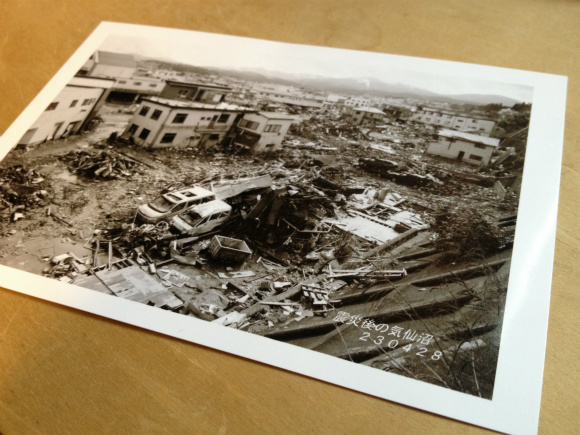Tokyo Electric Power Co. (TEPCO) announced that while transferring contaminated water containing radioactive material from leaking underground storage tank No. 3 to tank No. 6 at the Fukushima Daiichi Nuclear Power Plant on April 11 this year, water was discovered leaking from a joint connecting the piping being used for the transfer.
About 22 liters of water containing 6.4 billion becquerels of radioactive material leaked from the joint before the problem was chanced upon. TEPCO said the water leaked on top of the berm covering the storage tank and that there was no possibility of it seeping into the soil surrounding it.
Read More












 Japanese train station vending machine has the best souvenirs for rail otaku
Japanese train station vending machine has the best souvenirs for rail otaku Station of despair: What to do if you get stuck at the end of Tokyo’s Chuo Rapid Line
Station of despair: What to do if you get stuck at the end of Tokyo’s Chuo Rapid Line Sailor Moon and J-pop mega-star Ayumi Hamasaki team up for collaboration, pre-defeat scalpers
Sailor Moon and J-pop mega-star Ayumi Hamasaki team up for collaboration, pre-defeat scalpers Kura Sushi has a new parade-delivered whole cake dessert, but what’s it like to eat?【Video】
Kura Sushi has a new parade-delivered whole cake dessert, but what’s it like to eat?【Video】 Police called out to investigate suspicious Santa in Wakayama
Police called out to investigate suspicious Santa in Wakayama Celebrating legal marriage days in Japan with budget-friendly photoshoots
Celebrating legal marriage days in Japan with budget-friendly photoshoots This downtown Tokyo cafe is like a time machine that takes you back 50 years into the past
This downtown Tokyo cafe is like a time machine that takes you back 50 years into the past Japanese company develops classy heavy metal band frames for glasses
Japanese company develops classy heavy metal band frames for glasses Japanese government will check and judge new baby name pronunciations, presents guidelines
Japanese government will check and judge new baby name pronunciations, presents guidelines World’s first real ramen in a can now available at Japanese vending machines
World’s first real ramen in a can now available at Japanese vending machines One of Japan’s rarest sweets is a sell-out hit that looks and tastes like frost
One of Japan’s rarest sweets is a sell-out hit that looks and tastes like frost Studio Ghibli showcases traditional craftsmanship with new wallet range
Studio Ghibli showcases traditional craftsmanship with new wallet range Mysterious light-up rainy night-sound Totoro figure doesn’t actually show a scene from the anime
Mysterious light-up rainy night-sound Totoro figure doesn’t actually show a scene from the anime Major Japanese city is abolishing extracurricular activities at all of its middle schools
Major Japanese city is abolishing extracurricular activities at all of its middle schools Spirited Away and Princess Mononoke plushies show a softer side of formidable Ghibli characters
Spirited Away and Princess Mononoke plushies show a softer side of formidable Ghibli characters Shakey’s is back! All-you-can-eat pizza chain returns to downtown Tokyo’s Shinjuku
Shakey’s is back! All-you-can-eat pizza chain returns to downtown Tokyo’s Shinjuku Possessing Harry Potter’s Sword of Godric Gryffindor is now illegal in Japan
Possessing Harry Potter’s Sword of Godric Gryffindor is now illegal in Japan Uniqlo announces first-ever collaboration with horror manga master Junji Ito【Photos】
Uniqlo announces first-ever collaboration with horror manga master Junji Ito【Photos】 J-pop mega star Ado reveals she’s been living in the U.S., may not understand language acquisition
J-pop mega star Ado reveals she’s been living in the U.S., may not understand language acquisition Starbucks Japan is calling it quits with paper straws
Starbucks Japan is calling it quits with paper straws Studio Ghibli releases new range of cardigans for anime fans
Studio Ghibli releases new range of cardigans for anime fans Japan’s most popular castle raising ticket prices by up to 200 percent for non-local tourists
Japan’s most popular castle raising ticket prices by up to 200 percent for non-local tourists Furikake rice seasoning sales are soaring, which is bad news for Japan as a whole
Furikake rice seasoning sales are soaring, which is bad news for Japan as a whole Studio Ghibli heroine cardigans give you warmth and strength to face everyday challenges
Studio Ghibli heroine cardigans give you warmth and strength to face everyday challenges Eight unforgettable hot springs, as recommended by Japan’s “Professor Bath”
Eight unforgettable hot springs, as recommended by Japan’s “Professor Bath” McDonald’s new Happy Meals offer up cute and practical Sanrio lifestyle goods
McDonald’s new Happy Meals offer up cute and practical Sanrio lifestyle goods Foreign tourists on Shinkansen bullet train break suitcase etiquette, angering local passengers
Foreign tourists on Shinkansen bullet train break suitcase etiquette, angering local passengers [Deleted] Article written for April Fool’s Day 2018
[Deleted] Article written for April Fool’s Day 2018 Japanese government to make first change to romanization spelling rules since the 1950s
Japanese government to make first change to romanization spelling rules since the 1950s Foreigner’s request for help in Tokyo makes us sad for the state of society
Foreigner’s request for help in Tokyo makes us sad for the state of society Japanese convenience store Family Mart announces abolishment of eat-in spaces
Japanese convenience store Family Mart announces abolishment of eat-in spaces Life-size vibrating Legend of Zelda Master Sword for sale from Nintendo【Photos】
Life-size vibrating Legend of Zelda Master Sword for sale from Nintendo【Photos】 Princesses, fruits, and blacksmiths: Study reveals the 30 most unusual family names in Japan
Princesses, fruits, and blacksmiths: Study reveals the 30 most unusual family names in Japan Studio Ghibli releases free-download board game — Here’s how to play it without reading Japanese
Studio Ghibli releases free-download board game — Here’s how to play it without reading Japanese Celebrating legal marriage days in Japan with budget-friendly photoshoots
Celebrating legal marriage days in Japan with budget-friendly photoshoots This downtown Tokyo cafe is like a time machine that takes you back 50 years into the past
This downtown Tokyo cafe is like a time machine that takes you back 50 years into the past Japanese company develops classy heavy metal band frames for glasses
Japanese company develops classy heavy metal band frames for glasses Japanese government will check and judge new baby name pronunciations, presents guidelines
Japanese government will check and judge new baby name pronunciations, presents guidelines World’s first real ramen in a can now available at Japanese vending machines
World’s first real ramen in a can now available at Japanese vending machines Totoro towels gently glow in the dark to set the Ghibli nighttime mood in your home【Photos】
Totoro towels gently glow in the dark to set the Ghibli nighttime mood in your home【Photos】 Shimonoseki’s Koreantown isn’t like Tokyo’s or Osaka’s, but it has a retro atmosphere all its own
Shimonoseki’s Koreantown isn’t like Tokyo’s or Osaka’s, but it has a retro atmosphere all its own What happens when our reporters show up to work dressed like their fathers?
What happens when our reporters show up to work dressed like their fathers? Japanese-style accommodation at the new Premium Dormy Inn hotel in Asakusa will blow your mind
Japanese-style accommodation at the new Premium Dormy Inn hotel in Asakusa will blow your mind Tokyo has a “phantom egg shop” with ingredients for the best tamago-kake gohan rice bowl ever
Tokyo has a “phantom egg shop” with ingredients for the best tamago-kake gohan rice bowl ever Yakuza vending machines coming to real-world Tokyo neighborhood that inspired Like a Dragon games
Yakuza vending machines coming to real-world Tokyo neighborhood that inspired Like a Dragon games Nakano Broadway sells a fukubukuro lucky bag for foreigners, but is it a good deal or a scam?
Nakano Broadway sells a fukubukuro lucky bag for foreigners, but is it a good deal or a scam?